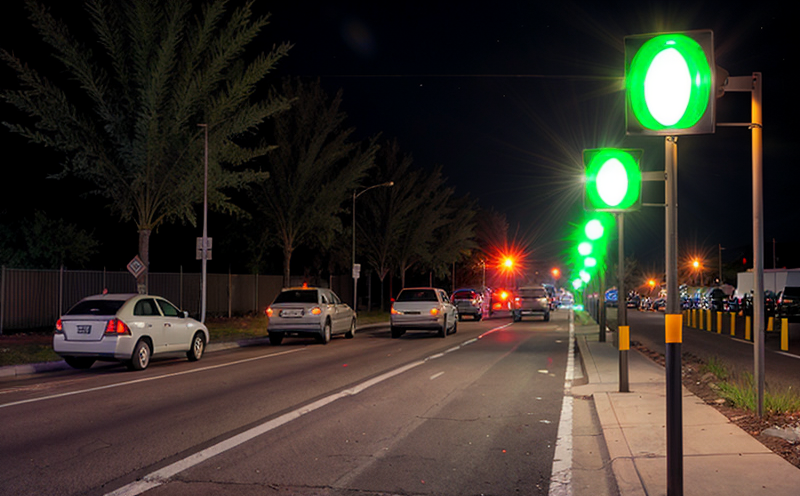ASTM D1003 Haze and Transparency Testing of Traffic Signal Lenses
The ASTM D1003 standard is a critical tool used in the evaluation of traffic signal lenses to ensure they meet stringent performance requirements. This test measures two key optical properties: haze and transparency, which are essential for ensuring that traffic signals remain visible and legible under various environmental conditions.
Haze affects how light passes through a material, causing some light to be scattered or diffused, while reducing the overall clarity of the signal's color and intensity. Transparency ensures that the light emitted by the traffic signal is not significantly distorted as it travels through the lens, maintaining the integrity of the signal's message.
The importance of these properties cannot be overstated in the context of road safety. A poorly performing lens can lead to reduced visibility during adverse weather conditions or at night, potentially causing confusion for drivers and pedestrians, thereby increasing the risk of accidents. Therefore, compliance with ASTM D1003 is not just a regulatory requirement but also an essential step towards enhancing public safety.
The testing process involves exposing lenses to standardized light sources under controlled environmental conditions to simulate real-world usage scenarios. The test apparatus used includes a spectrophotometer capable of measuring the transmittance and haze values accurately. This equipment allows for precise quantification of how much light is lost or scattered as it passes through the lens, providing critical data for quality control and product improvement.
Compliance with ASTM D1003 ensures that traffic signal lenses meet international standards set forth by organizations such as ISO, ASTM, and others. This standard is recognized worldwide, ensuring that the products are not only safe but also reliable across different climatic zones.
The results of this testing play a pivotal role in product development and quality assurance processes. By identifying any deficiencies early on, manufacturers can make necessary adjustments to their production processes, ensuring that all traffic signal lenses meet or exceed the required standards. This proactive approach not only enhances public safety but also supports regulatory compliance, reducing potential legal risks associated with non-compliance.
Scope and Methodology
| Aspect | Description |
|---|---|
| Test Specimens | The test specimens are typically traffic signal lenses made of various materials like polycarbonate, acrylic, or glass. These lenses must be clean and free from any imperfections that could affect the test results. |
| Light Sources | The light sources used in the testing process are standardized to ensure consistency across different tests. Typically, these include halogen lamps or LED arrays capable of emitting white light with a color temperature close to daylight conditions. |
| Measurement Instruments | A spectrophotometer is used to measure both transmittance and haze values accurately. The instrument should be calibrated regularly to ensure precise measurements. |
| Data Collection | The collected data includes the percentage of light transmitted through the lens, the amount of scattered light (haze), and any deviations from expected color performance. |
| Environmental Conditions | The testing is conducted under controlled environmental conditions to mimic real-world scenarios. This includes temperature control, humidity levels, and exposure time. |
Competitive Advantage and Market Impact
Compliance with ASTM D1003 provides manufacturers of traffic signal lenses a significant competitive edge in the market. By ensuring that their products meet or exceed international standards, they demonstrate a commitment to quality and safety, which can enhance brand reputation and customer trust.
In addition to regulatory compliance, meeting these standards can also lead to increased sales by appealing to environmentally conscious consumers who prioritize sustainability and product longevity. The ability to supply high-quality traffic signal lenses that perform consistently across diverse conditions is particularly valuable in competitive markets where reliability and performance are paramount.
The market for traffic signal lenses is highly regulated due to its critical role in road safety. Companies that invest in rigorous testing, including ASTM D1003 haze and transparency testing, position themselves as leaders in this industry. This not only attracts more customers but also opens up opportunities for collaboration with other reputable entities within the sector.
Moreover, compliance with such standards can help manufacturers navigate regulatory changes and adapt to evolving market demands. By staying ahead of the curve through continuous testing and improvement, they ensure their products remain relevant and effective in an ever-changing landscape.
Use Cases and Application Examples
The ASTM D1003 haze and transparency testing is widely used across various applications within the traffic & signaling lighting sector. One of the primary use cases involves ensuring that traffic signal lenses remain effective over extended periods, especially in environments where exposure to UV light or extreme temperatures can degrade material properties.
Another critical application is during product development stages when manufacturers need to evaluate new materials and designs for their suitability in producing traffic signal lenses. This helps identify potential issues early on before committing resources to full-scale production.
A third example involves quality assurance processes at manufacturing facilities where periodic testing ensures that each batch of lenses meets the required standards consistently. This not only enhances product reliability but also reduces the likelihood of recalls or returns, saving time and resources in the long run.
Real-world usage notes highlight how these tests contribute significantly to maintaining visibility during adverse weather conditions such as fog, rain, snow, etc. By ensuring that light is transmitted efficiently through the lenses despite external factors, these tests play a crucial role in enhancing road safety worldwide.





